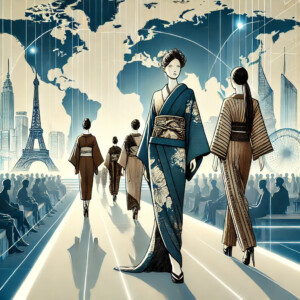Introduction The kimono, a symbol of Japan’s rich cultural heritage, has transcended its traditional roots to become a significant element in modern Japanese pop culture. While the kimono is often associated with formality and tradition, its influence permeates contemporary fashion, media, and global trends. This article explores the evolution of the kimono in modern Japanese pop culture, highlighting its enduring appeal and versatility in today’s world.

Section 1: Historical Significance of Kimono and Its Evolution The kimono’s history dates back over a thousand years, with its roots in the Heian period (794-1185). Originally, the kimono was a common garment for all, evolving in style, fabric, and function over the centuries. By the Edo period (1603-1868), the kimono had become a symbol of status and wealth, with intricate designs and luxurious materials reserved for the elite. The Meiji Restoration (1868-1912) brought Western influences, leading to a decline in everyday kimono wear. However, the kimono remained a ceremonial garment, representing Japan’s cultural identity.
In the 20th century, the kimono experienced a resurgence in popularity, especially in the realms of fashion and entertainment. Designers began to experiment with traditional designs, introducing modern twists while preserving the essence of the kimono. This evolution allowed the kimono to transition from a strictly traditional garment to a versatile piece that could be adapted to various contexts.

Section 2: Kimono in Contemporary Japanese Media (Anime, Film, Music) The kimono’s presence in contemporary Japanese media, especially anime, film, and music, plays a crucial role in keeping the garment relevant and popular among younger generations. In anime, characters often don kimonos, especially during significant events or festivals, reinforcing the garment’s cultural importance. Series like Demon Slayer (Kimetsu no Yaiba) showcase characters in distinctive kimonos, which have become iconic and influential in real-world fashion.
In film, the kimono is frequently used to symbolize a character’s connection to tradition or heritage. Movies like Memoirs of a Geisha and Sukiyaki Western Django prominently feature kimonos, blending traditional and modern storytelling. The garment’s visual appeal and cultural resonance make it a powerful tool in cinematic narratives.
Music, particularly J-Pop and visual kei bands, also incorporates kimono-inspired fashion. Artists often blend traditional kimonos with contemporary elements, creating a fusion of old and new that appeals to a wide audience. This creative adaptation highlights the kimono’s versatility and its ability to transcend cultural and generational boundaries.

Section 3: Influence of Kimono in Global Fashion Trends The influence of the kimono has extended beyond Japan, making a significant impact on global fashion. International designers have drawn inspiration from the kimono’s structure, fabric, and aesthetics, integrating these elements into modern fashion collections. Brands like Yohji Yamamoto, Issey Miyake, and even Western designers have introduced kimono-inspired pieces, blending traditional Japanese elements with contemporary fashion trends.
The kimono’s influence can be seen in the rise of “kimono-style” garments, which incorporate the garment’s iconic silhouette and design features but are adapted for modern, everyday wear. This global adoption has sparked renewed interest in the kimono, both as a fashion statement and as a symbol of cultural appreciation.

Section 4: Modern Interpretations and Adaptations of Kimono in Everyday Wear In Japan, modern interpretations of the kimono have led to a revival of the garment in everyday wear. Designers and fashion enthusiasts are reimagining the kimono for contemporary lifestyles, creating pieces that are both practical and stylish. These modern kimonos often feature simplified designs, lighter fabrics, and versatile styles that can be worn casually or formally.
Initiatives like the “Kimono Project” and “Kimono Fusion” have further promoted the garment’s modern relevance, encouraging people to incorporate kimonos into their daily lives. These efforts aim to preserve the cultural significance of the kimono while adapting it to the needs and preferences of today’s fashion-conscious society.
Conclusion: The Future of Kimono in Global Fashion The kimono’s journey from a traditional Japanese garment to a global fashion icon illustrates its enduring appeal and adaptability. As the world continues to embrace diversity and cultural exchange, the kimono’s influence is likely to grow, inspiring new generations of designers and fashion enthusiasts. The kimono’s role in modern Japanese pop culture, as seen in media, fashion, and everyday wear, ensures that this iconic garment will continue to be a symbol of Japanese culture for years to come.
Comment